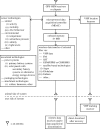Global positioning system and associated technologies in animal behaviour and ecological research
- PMID: 20566494
- PMCID: PMC2894966
- DOI: 10.1098/rstb.2010.0090
Global positioning system and associated technologies in animal behaviour and ecological research
Abstract
Biologists can equip animals with global positioning system (GPS) technology to obtain accurate (less than or equal to 30 m) locations that can be combined with sensor data to study animal behaviour and ecology. We provide the background of GPS techniques that have been used to gather data for wildlife studies. We review how GPS has been integrated into functional systems with data storage, data transfer, power supplies, packaging and sensor technologies to collect temperature, activity, proximity and mortality data from terrestrial species and birds. GPS 'rapid fixing' technologies combined with sensors provide location, dive frequency and duration profiles, and underwater acoustic information for the study of marine species. We examine how these rapid fixing technologies may be applied to terrestrial and avian applications. We discuss positional data quality and the capability for high-frequency sampling associated with GPS locations. We present alternatives for storing and retrieving data by using dataloggers (biologging), radio-frequency download systems (e.g. very high frequency, spread spectrum), integration of GPS with other satellite systems (e.g. Argos, Globalstar) and potential new data recovery technologies (e.g. network nodes). GPS is one component among many rapidly evolving technologies. Therefore, we recommend that users and suppliers interact to ensure the availability of appropriate equipment to meet animal research objectives.
Figures


References
-
- Aastrup P.2009Caribou movements in West Greenland. Studies in relation to proposed industrial development. Rangifer Rep. 13, 88–89
-
- Barbari M., Conti L., Koostra B. K., Masi G. F., Guerri F. S., Workman S. R.2006The use of Global Positioning and Geographical Information Systems in the management of extensive cattle grazing. Biosyst. Eng. 95, 271–280 (doi:10.1016/j.biosystemseng.2006.06.012) - DOI
-
- Brooks C., Bonyongo C., Harris S.2008Effects of Global Positioning System collar weight on zebra behavior and location error. J. Wildl. Manage. 72, 527–534 (doi:10.2193/2007-061) - DOI
-
- Cadahia L., Urios V., Negro J. J.2007Bonelli's Eagle Hieraaetus fasciatus juvenile dispersal: hourly and daily movements tracked by GPS. Bird Study 54, 271–274 (doi:10.1080/00063650709461484) - DOI
-
- Cagnacci F., Boitani L., Powell R., Boyce M.2010Animal ecology meets GPS-based radiotelemetry: a perfect storm of opportunities and challenges. Phil. Trans. R. Soc. B 365, 2157–2162 (doi:10.1098/rstb.2010.0107) - DOI - PMC - PubMed
Publication types
MeSH terms
LinkOut - more resources
Full Text Sources

